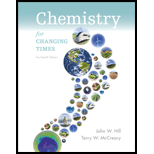
Chemistry For Changing Times (14th Edition)
14th Edition
ISBN: 9780321972026
Author: John W. Hill, Terry W. McCreary
Publisher: PEARSON
expand_more
expand_more
format_list_bulleted
Concept explainers
Question
Chapter 3, Problem 3.3CTE
Interpretation Introduction
Interpretation:
Pssiblity of silicon present in other planet should be identified.
Concept introduction:
Earth having almost everything to survive with nature and moreover the life on earth based on carbon as the age of rocks and plants are based on carbon dating whereas coal which gets converted to diamond after a long time also contains carbon in it.
Expert Solution & Answer
Want to see the full answer?
Check out a sample textbook solution
Students have asked these similar questions
Describe a sequence of photophysical processes that can be followed by radiation adsorbed by a molecule in the ground state to give rise to phosphorescent emission.
State two similarities between fluorescence and phosphorescence.
State three photophysical processes that can be related to the effects of incident radiation on a molecule in its ground state. Consider that radiation can give rise to fluorescent emission, but not phosphorescent emission.
Chapter 3 Solutions
Chemistry For Changing Times (14th Edition)
Ch. 3 - What did each of the following scientists...Ch. 3 - What is radioactivity? How did the discovery of...Ch. 3 - How are X-rays and gamma rays similar? How are...Ch. 3 - How was Goldstein's experiment different from...Ch. 3 - In Rutherford's model of the atom, where are the...Ch. 3 - Prob. 6RQCh. 3 - Prob. 7RQCh. 3 - Prob. 8RQCh. 3 - Prob. 9RQCh. 3 - 10. What are the symbol, name, and atomic number...
Ch. 3 - What are the symbol, name, and atomic number of...Ch. 3 - Prob. 12RQCh. 3 - Prob. 13RQCh. 3 - 14. How did Bohr and Schrodinger refine the model...Ch. 3 - Prob. 15RQCh. 3 - 16. Use the periodic table to determine the number...Ch. 3 - Prob. 17RQCh. 3 - Prob. 18PCh. 3 - Prob. 19PCh. 3 - Prob. 20PCh. 3 - Prob. 21PCh. 3 - A neutral atom with 9 protons will have how many...Ch. 3 - Give the symbol and name for (a) an isotope with a...Ch. 3 - Fill in the table: Element Mass Number Number of...Ch. 3 - Prob. 25PCh. 3 - Prob. 26PCh. 3 - Prob. 27PCh. 3 - Prob. 28PCh. 3 - Prob. 29PCh. 3 - Prob. 30PCh. 3 - Without referring to the periodic table, give the...Ch. 3 - Prob. 32PCh. 3 - 33. Indicate whether each electron configuration...Ch. 3 - Prob. 34PCh. 3 - Prob. 35PCh. 3 - Prob. 36PCh. 3 - Prob. 37PCh. 3 - Referring only to the periodic table, tell how the...Ch. 3 - Prob. 39PCh. 3 - Use the following list of elements to answer...Ch. 3 - Prob. 41PCh. 3 - Prob. 42PCh. 3 - Prob. 43PCh. 3 - Use the following list of elements to answer...Ch. 3 - Prob. 45APCh. 3 - Prob. 46APCh. 3 - Prob. 47APCh. 3 - Look again at Figure 3.11. A patient is found to...Ch. 3 - Refer to Figure 3.16 and write the electron...Ch. 3 - Prob. 50APCh. 3 - Prob. 51APCh. 3 - Prob. 52APCh. 3 - Prob. 53APCh. 3 - Prob. 54APCh. 3 - 55. Which of the following is not a benefit of...Ch. 3 - Prob. 56APCh. 3 - Prob. 3.1CTECh. 3 - Prob. 3.2CTECh. 3 - Prob. 3.3CTECh. 3 - Prob. 3.4CTECh. 3 - Prepare a PowerPoint, poster, or other...Ch. 3 - Prob. 2CGPCh. 3 - Prob. 3CGPCh. 3 - Prepare a PowerPoint, poster, or other...Ch. 3 - Prob. 1CHQCh. 3 - Materials requried
Colorflame birthday candles...Ch. 3 - Prob. 3CHQCh. 3 - Prob. 4CHQCh. 3 - Prob. 5CHQ
Knowledge Booster
Learn more about
Need a deep-dive on the concept behind this application? Look no further. Learn more about this topic, chemistry and related others by exploring similar questions and additional content below.Similar questions
arrow_back_ios
SEE MORE QUESTIONS
arrow_forward_ios
Recommended textbooks for you
 ChemistryChemistryISBN:9781305957404Author:Steven S. Zumdahl, Susan A. Zumdahl, Donald J. DeCostePublisher:Cengage Learning
ChemistryChemistryISBN:9781305957404Author:Steven S. Zumdahl, Susan A. Zumdahl, Donald J. DeCostePublisher:Cengage Learning ChemistryChemistryISBN:9781259911156Author:Raymond Chang Dr., Jason Overby ProfessorPublisher:McGraw-Hill Education
ChemistryChemistryISBN:9781259911156Author:Raymond Chang Dr., Jason Overby ProfessorPublisher:McGraw-Hill Education Principles of Instrumental AnalysisChemistryISBN:9781305577213Author:Douglas A. Skoog, F. James Holler, Stanley R. CrouchPublisher:Cengage Learning
Principles of Instrumental AnalysisChemistryISBN:9781305577213Author:Douglas A. Skoog, F. James Holler, Stanley R. CrouchPublisher:Cengage Learning Organic ChemistryChemistryISBN:9780078021558Author:Janice Gorzynski Smith Dr.Publisher:McGraw-Hill Education
Organic ChemistryChemistryISBN:9780078021558Author:Janice Gorzynski Smith Dr.Publisher:McGraw-Hill Education Chemistry: Principles and ReactionsChemistryISBN:9781305079373Author:William L. Masterton, Cecile N. HurleyPublisher:Cengage Learning
Chemistry: Principles and ReactionsChemistryISBN:9781305079373Author:William L. Masterton, Cecile N. HurleyPublisher:Cengage Learning Elementary Principles of Chemical Processes, Bind...ChemistryISBN:9781118431221Author:Richard M. Felder, Ronald W. Rousseau, Lisa G. BullardPublisher:WILEY
Elementary Principles of Chemical Processes, Bind...ChemistryISBN:9781118431221Author:Richard M. Felder, Ronald W. Rousseau, Lisa G. BullardPublisher:WILEY

Chemistry
Chemistry
ISBN:9781305957404
Author:Steven S. Zumdahl, Susan A. Zumdahl, Donald J. DeCoste
Publisher:Cengage Learning

Chemistry
Chemistry
ISBN:9781259911156
Author:Raymond Chang Dr., Jason Overby Professor
Publisher:McGraw-Hill Education

Principles of Instrumental Analysis
Chemistry
ISBN:9781305577213
Author:Douglas A. Skoog, F. James Holler, Stanley R. Crouch
Publisher:Cengage Learning

Organic Chemistry
Chemistry
ISBN:9780078021558
Author:Janice Gorzynski Smith Dr.
Publisher:McGraw-Hill Education

Chemistry: Principles and Reactions
Chemistry
ISBN:9781305079373
Author:William L. Masterton, Cecile N. Hurley
Publisher:Cengage Learning

Elementary Principles of Chemical Processes, Bind...
Chemistry
ISBN:9781118431221
Author:Richard M. Felder, Ronald W. Rousseau, Lisa G. Bullard
Publisher:WILEY
Atomic Number, Atomic Mass, and the Atomic Structure | How to Pass ChemistryThe Nucleus: Crash Course Chemistry #1; Author: Crash Course;https://www.youtube.com/watch?v=FSyAehMdpyI;License: Standard YouTube License, CC-BY